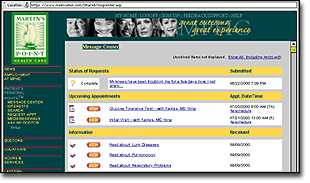
Interactive practice Web sites can make you available to patients when and where they need you.
Fam Pract Manag. 2000;7(9):64-65
I predict many of the information technology-based products currently being marketed to physicians won't survive because they don't deliver the promised value. Palm-top, single-purpose, prescription-writing devices are my pick for the eHealth dustbin in 2001, no matter how cute the little devils are. Why? Because to be truly valuable to the medical community, these products must do more than simply automate a single business process. They must help health care professionals do several things better and more efficiently and strengthen the patient-physician relationship in the process.
What's going to be a winner? My pick is interactive practice-based communication via the World Wide Web. Why? Patients seem to love using the Internet to communicate with their physicians, and physicians and staffs are finding that their workflow becomes more manageable when they do.
Consider Martin's Point Health Care, a primary care group with four physician practices in Maine and New Hampshire. In June of 1999, the group began offering patients online access to their practice via secured, personalized Web pages they call “Patient's Personal Points.” Roy Nakamura, MD, a family physician at Martin's Point, championed using interactive Web pages as an alternative to playing telephone tag with patients.
The Patient's Personal Points system provides patients with their own Web pages that they can use at their convenience to schedule or reschedule appointments, request refills on medications and ask their physicians nonurgent, health-related questions. Martin's Point staff also uses the Web pages to remind patients of upcoming appointments and provide them with relevant patient education materials so they may better understand and care for their medical conditions. [The screen shot below shows you what a patient might see. To see a demonstration of the program, go to www.medivation.com. From there, select “Patient's Personal Points” from the left-hand column. Then choose one of the activities listed (e.g., “Request appt”) and click on the “Preview” button.]

Patients can schedule appointments, receive answers to their questions and obtain health-related educational information through the Patient's Personal Points message cente
Launching the site
Before initiating Web-based patient communication, Martin's Point carefully surveyed its patients to gauge their interest and found 65 percent had Internet access and would welcome the service. “I believe most practices will be implementing this kind of system in the very near future because it's so affordable and easy to get up and running,” says Nakamura. “However, we couldn't have done this by ourselves.”
The group partnered with MediVation, a company recently purchased by iMcKesson (www.imckesson.com), for the technology behind the service [see also “Sources for Web-based communications”]. MediVation provided the software application, generated the actual Web pages and created the interface with the practice's existing computer system so the Web pages can be updated daily. It also maintains the hardware, database and software for Martin's Point at an off-site data center – all for a cost much less than Martin's Point would have incurred if the group had developed its own in-house solution.
Sources for Web-based communications
The following companies use the same Internet technology to provide secure, Web-based patient-practice communications. You can learn more about what they offer by visiting their Web sites.
PatientSite
CareGroup HealthCare System
www.patientsite.caregroup.org
CAREvision
HEALTHvision
www.healthvision.com/overview/solutionsuite/CareVision
MediVation
iMcKesson
www.medivation.com
98point6
MedicaLogic
www.98point6.com
Nakamura is convinced that Martin's Point is more efficient as a result. “Every message I get from a patient on this system is one less phone call to our switchboard, and all our communications are documented in hard copy, which is important for medicolegal reasons.”
The staff at Martin's Point use the familiar Web browser Internet Explorer (www.microsoft.com) to access the Web pages via a cable modem connection to the Internet. All transactions are encrypted to maintain patient confidentiality. And, because Martin's Point controls the content of the Web pages, it can also use the site to keep patients informed of office news and events. Triage nurses handle the messages between patients and doctors, prioritizing the flow of information in much the same way as they would telephone calls.
“We started the program as an innovative customer-service tool that none of our competition would have, targeting busy families who might have difficulty communicating with us during regular office hours,” says Candice Labrecque, Martin's Point's director of practice administration. “Our patients really seem to appreciate being able to contact us when it's convenient to them.”
24/7
Just one year old, the Patient's Personal Points service is already being used by approximately 1,800 patients. “I think we'll see more and more patients demanding that we provide them with information when it fits their schedules, much like banks have made information about our accounts available online 24 hours a day,” Nakamura says. “Almost every day, patients thank me for being more available to them.”
Editor's note: This article is the third in a series on eHealth trends. Watch future issues of FPM to read more about Internet software applications as well as emerging eHealth companies.